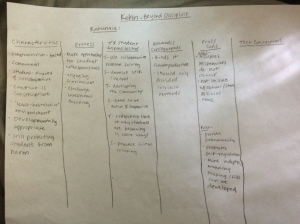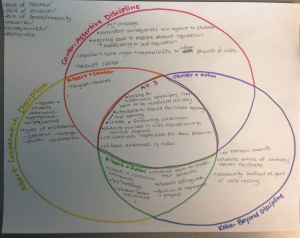Class began with a refresher of last weeks focus on Minor and Major Behaviors. As a large group we were prompted to describe/remind each other of the following key ideas from last week.
- Minor behaviors – distracts teaching but doesn’t stop it; however, these minor behaviors do have potential to escalate into major behaviors.
- Major behaviors – has potential to place students/peers in danger, disturbs whole class
- Minor behavior solutions: proximity to the problem, a quick verbal remark in which tone and infliction remains constant in which not to disturb the whole class, “teacher look” and removal of distracting item (e.g. pen).
- Major behavior solutions: *Teachers response to these behaviors can also determine how much time will be taken from lesson and how many other students will be effected and how the misbehaving student responds* relocation of the misbehaving student(s), call to the parent(s), and in extreme cases of safety calling a resource officer for assistance.
This week, we discussed how teachers can use proactive approaches to nip misbehavior before it starts and ways to address them should these behaviors take place in the classroom. We also had the opportunity to take on the ideas of veteran level teachers through text and video.
Here are some lists I made during class that are worth sharing on my blog because I will be using these as “anchor charts” in my classroom. No, not for the students to refer too but for my own personal and professional development. I intend to use the following list in my lesson planning binder that I will refer to and double check to be sure I have included these guidelines in my lessons. If and when (and let’s be honest when will inevitably occur) my lesson plans fail I will make a habit out of referring to this chart and asking where might I have had gaps in my presentation.
Levin & Nolan (2014) refers teachers to a collection of prerequisite behaviors that will help limit misbehaviors. An abbreviated version of the list is as follows:
- Be Prepared
- Provide Clear and Concise Directions
- Set a Purpose/Objective
- Be Clear About Evaluation Criteria (Rubrics are a great tool)
- Be Consistent
- Be Enthusiastic (Encourages Student Engagement Levels)
- Foster Caring Relationships/Build Sense of Community
As a class we included a few extra ideas (to the right I’ll identify where I think they fall in to the Levin & Nolan (2014) list from above):
- Remain Calm <— Foster caring relationships
- Plan For Your Students Needs <— Be prepared
- With-it-ness <— EVERYTHING ABOVE AND THEN SOME 🙂
- Classroom/Station Design Fits Lesson <— Be prepared
- Be Culturally Sensitive <— Be prepared & Foster caring relationships
- Create Interesting Lessons <— Be Prepared, Be Clear and Set a purpose
All of these ideas are really connecting to my other courses and texts. From Children’s Psychology where consistency and building trusting relationships can raise ones level of self-efficacy which ultimately results in higher performance levels to Teaching Elementary Mathematics where I’ve learned sparking interest levels is the first step to engage students in problem solving. Everything is beginning to connect and make sense.
In the following class assignment we took a look at the different ways teachers can adjust/monitor behaviors in their classroom. Assuming the ideas from Levin & Nolan’s list fail to work here are a few other approaches. To put concepts into practice, we were grouped and given a task of identifying solutions to each category below:
- Change the Pace – If students zone out encourage a quick stretching sessions, use tools and not the same structure of the previous class
- Interest Boosting – (see below)
- Redirect Behaviors – Remove distractors, “give notice such as – Erica, I’ll be calling on you next”, group reminders
- Encourage Appropriate Behaviors – Rewards, Specific Praise, Academic Parties, Calling out Student Models, ClassDojo App
- Provide Cues – Walk By, Tapping Desk, Teacher Look
My group was assigned #2 – Interest BoostingTechniques and here is what we came up with:
- Utilizing technology e.g. Interactive Whiteboards, geoboards.org
- Incorporate “play” in learning
- Groups/Classes with rotating roles
- Field trips as extrinsic motivation
One approach I had not immediately considered was to boost interest levels from daydreamers, distracted students, etc. by acknowledging their work positively (Levin & Nolan, 2014). Once you have the student(s) attention you can encourage him/her to show his work to their shoulder buddy or show us how you got to that solution using the interactive whiteboard. This will be an approach I carry on my tool belt and refer to frequently. While, daydreamers may not have started their work I can refer them to previous work they did well as a way to boost their esteem and in turn raise their level of interest.
Scenarios – What is a verbal cue to help him get start?
- Student won’t get started with desk work – First class reminder: “Is everyone clear on what the expectations are?” – Then student specific reminder: Repeat of question with students name first
- Student barrels through to the front of the line – “Name, I know you know better, please be a good role model to your friends and go back to your desk and start again.”
- Student blurts out to another student across the classroom while teacher is providing the class a lesson – “Really?” “Okay, that’s fine you and you keep talking..the rest of us will wait”
In the scenarios above I’m reminded of how the littlest response to behavior has the potential to make the greatest difference in the overall environment and outcome.
The BIGGEST take-away I had from today was when my professor said “I think for the next MAT cohort I will have observations begin with MAT students shadowing elementary students in order to gain their perspective”. My professor has 10+ years of teaching experience at various levels and it wasn’t until she came across the blog/article “A Veteran Teacher Turned Coach Shadows 2 Students for 2 Days — A Sobering Lesson Learned” that she was inspired to try something new (Wiggins, 2014). Why is this revelation so valuable to me? I am reassured that I will make mistakes and that things will still work out okay. I am confident that I will be open to learn from colleagues and other education professionals who may have a different perspective then what I currently can see. I am aware that one of the biggest mistakes a teacher (or individual for that matter) can make is being afraid to change; especially when change is brought about by scientific and academic research. As a teacher, my goal is to not only to encourage students to develop the skills needed to become higher order thinkers and learners but to also not let myself fall into a “stuck in my ways” mentality. Thanks for the unintentional life/professional lesson 🙂
My next blog will not be until the first week of December and will be the last blog I write until my second semester. I look forward to rereading these and seeing how my thoughts grow and change!
Until next week,
Erica
References
Wiggins, A. (2014). A Veteran Teacher Turned Coach Shadows 2 Students for 2 Days — A Sobering Lesson Learned. Retrieved from http://www.washingtonpost.com/blogs/answer-sheet/wp/2014/10/24/teacher-spends-two-days-as-a-student-and-is-shocked-at-what-she-learned/
Levin, J. & Nolan, J. (2014). Principles of Classroom Management: A Professional Decision-Making Model. Upper Saddle River, NJ: Pearson.

